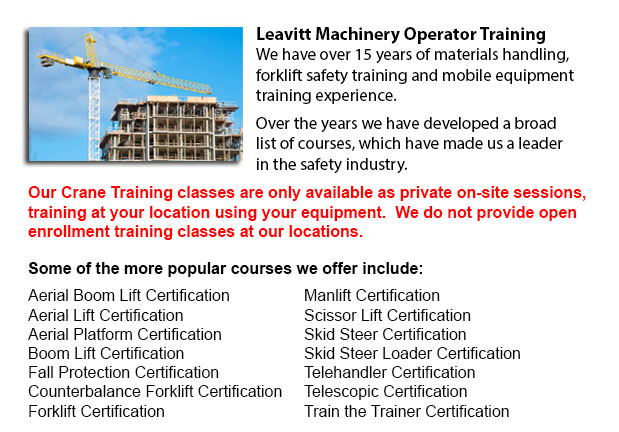
Vernon Overhead Crane Operator Training - Our overhead crane operator training course is intended to teach workers the basics of overhead crane/sling operation and pre-shift checks. Programs are taught by our expert trainers and consultants. Well-trained workers are more efficient and productive, which really saves on expenses connected with merchandise damage, property damage, and accidents because of the utilization of improper operating procedures. Our overhead crane certification is customized for employees who have literacy barriers, reducing certification time by 50 percent.
Overhead cranes are suitable for particular repetitive lifting activities. This type of crane has wide ranging capacities. They could be utilized for specialized hoisting tasks like for example installing or removing major plant equipment.
To safely make use of an overhead crane, staff need to employ safe rigging practices. This requires both practice and knowledge. The load must be rigged right to be able to guarantee its stability when lifted. Prior to starting a hoisting job, it should be determined that the crane is right for the task, with right capacity, travel and lift. The crane should be subjected to a thorough physical and visual check before use. The capacity of all machines, including the hardware, rope and slings, must never go beyond load weight capacities.
The rigger needs to know the right sling for each and every lift and check slings and other rigging hardware before utilizing. Clear signals must be used in communications with the crane operator. A signaler should be designated for the role and signals have to be agreed upon. The operator of the crane must follow instructions just from the designated individual. If a wired or remote controller is being used, the operator should be trained in all its functions.
In order to ensure the safety of personnel, a warning needs to be issued and the path of the load must be cleared of all hazards before the lift starts. Individuals must not be allowed to walk below the lift loads. The crane hoist has to be centered over the load prior to lifting in order to prevent swinging. The safety catch must be closed immediately after sliding the sling entirely onto the hoisting hook. Sling legs which are not used should be secured so they do not drag. Never leave loose materials on a load being lifted. Watch that fingers and hands are clear when slack is taken out of a sling. Before the lift is carried out, step clear of the danger zone.
-
Vernon Heavy Equipment Training Programs
Vernon Heavy Equipment Training Programs - At whatever given construction site, there are often different types of machinery which are ready to be used. These heavy and light machines need both operators to run them and mechanics to fix them. Trainee... More -
Vernon Forklift Safety Training
Vernon Forklift Safety Training - People wanting work in industries that operate lift trucks should undergo a forklift safety training program before becoming a certified operator of a lift truck. There are a lot of ways to go about acquiring forklif... More -
Vernon Aerial Boom Lift Ticket
Vernon Aerial Boom Lift Ticket - Aerial platform lifts can accommodate various odd jobs involving high and tough reaching places. Normally used to complete regular preservation in structures with tall ceilings, prune tree branches, elevate heavy shel... More -
Vernon Manlift Safety Training
Vernon Manlift Safety Training - Manlift operators need to be cognizant and aware of all the potential dangers which are associated with particular classes of scissor lifts. They need to be able to operate the scissor lift in a way that protects not... More -
Vernon Forklift License
Vernon Forklift License - Obtaining a forklift certification or forklift license in North America will require the one training to carry out hands-on training in addition to classroom instruction. The provincial, federal and state regulatory bodies a... More -
Narrow Aisle Forklift, Order Picker, Electric Pallet Jack, Electric Pallet Truck Certification in Vernon
A pallet lift is a model of equipment dedicated in the transporting of pallets of many dimensions and weights. They can be utilized as an appendage for forklifts, cranes and other styles of heavy machinery or be applied on their own. Pallet hoists ar... More -
Vernon Boom Lift Safety Training
Vernon Boom Lift Safey Training - Boom lifts are a type of elevated work platform or aerial lifting device which are commonly utilized in construction, industry, and warehousing. Boom lifts can be utilized in practically any surroundings because of t... More -
Vernon Manlift Operator Training
Vernon Manlift Operator Training - The aerial lift or manlift is a specialized kind of hydraulic platform that is designed to lift a person vertically giving it an alternate name of a vertical personnel lift. These machinery are widely utilized for a... More

Forklift Certification Vernon
TOLL FREE: 1-888-254-6157
Vernon, British Columbia
forkliftcertificationvernon.com
Email Us
About Us


